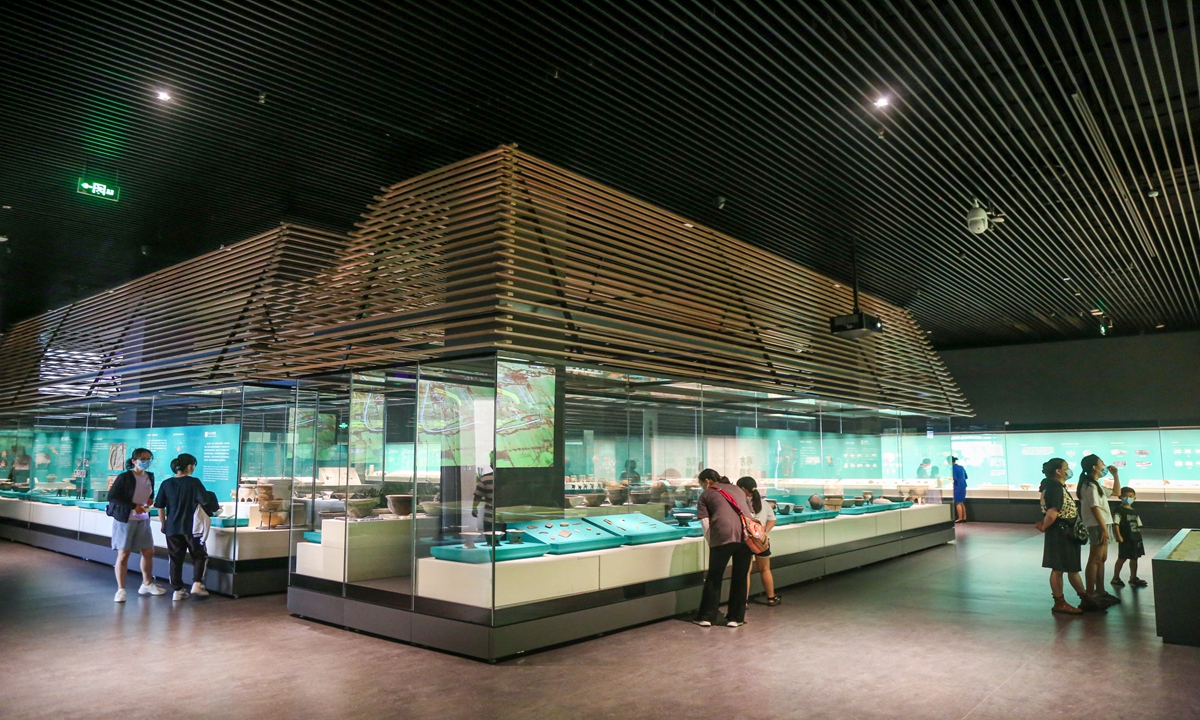
The Zhengzhou Shang Dynasty Relics Museum opens to the public on July 26, 2022. Photo: IC
From the majestic bronze sacrificial vessel Simuwu Ding to the spectacular chariot pulled by six white horses, when China's classic Romance of the Investiture of the Gods was adapted into a fantasy epic film by director Wu Ershan, he revealed that the production team visited as many museums as possible to prepare the most authentic props during production.
What may not be as apparent to him are the benefits the movie Creation of The Gods Ⅰ: Kingdom of Storms has brought to these cultural institutions, as people now showed a renewed interest and enthusiasm for museums, intent on appreciating cultural artifacts from 3,600 years ago.
Deputy Director of the Shang Dynasty Relics Museum Ma Yupeng told the Global Times (GT) that he's been happy that many artifacts from the dynasty's period not only tell the story of Shang culture (one of the earliest recorded cultures in China) but can also help the museum to gain more popularity.
The history of the Shang Dynasty (c.1600BC-1046BC) dating back to more than 3,000 years ago also encapsulates the glorious history of China's bronze ware. Surrounding the Yellow River, this culture, having developed around the central plains and western part of China, has left numerous buried historical treasures unearthed by successive generations of anthropologists and historians.
GT visited the historical ruins of the ancient capital of the Shang Dynasty, located in present-day Zhengzhou, the capital city of Central China's Henan Province, where the center of this aged city is buried. To one side of the ruins stands a brand new Shang Dynasty Relics Museum that opened just one year ago.
"Here, you can feel the very well-developed process of bronze civilization from inception to maturity," Ma said.
Time-traveling relics
The Creation of The Gods Ⅰ: Kingdom of Storms Chinese fantasy epic that has embarked on its overseas journey in North America, Australia, New Zealand, and the UK among other countries, is still soaring in popularity in China, sparking public interest in Shang culture.
According to data from Mafengwo, a Chinese tourism data platform, the popularity of the Shang Dynasty Ruins in Anyang, Henan, once increased by 200 percent week-on-week in August this year. Its influence can also be seen inside the museum and the National Archaeological Site Park of the Zhengzhou Shang Dynasty where the museum sits. Hao Xiaoyi, a visitor to the site, revealed that she also had another purpose for this trip: The museum's mainstay, a bronze axe named yue engraved with animal face patterns, whose majestic shape and elaborate ornamentation reflect the mastery of the mature and superb art of bronze casting technology by the ancestors during the early Shang period. "As the movie begins, the weapon held by Yinshou, one of the kings of Shang, bears a striking resemblance to an axe like this one. But when you take a closer look at the original piece of this with your own eyes, it feels incredible!"
"Such an axe was a symbol of the king's power and status. As a ritual axe, it had a flat mouth and no edge. But such axes also served as effective weapons during wars," a museum guide told GT, adding that most of them were discovered in imperial tombs. "Archaeologists have confirmed that Zhengzhou was where King Tang of the Shang Dynasty established his capital. As the founding capital of the Shang Dynasty, this museum is an important conservator and source of support for the exploration of the early Chinese civilization," Ma noted.
"The Zhengzhou Shang Dynasty archaeological site offers a glimpse into the development level of the early Shang civilization, filling in the gaps regarding Shang culture, and lays the foundation for the exploration of Xia culture as well."
A young base
The 3,600-year-old ruins, however, has a youthful heart.
After 70 years of archaeological excavation, tens of thousands of cultural relics have been unearthed from the Zhengzhou Shang Dynasty ruins site. And the Zhengzhou Shang Dynasty Relics Museum, which opened in 2022, now displays more than 1,000 cultural relics such as bronze ware, jade ware, bone ware, and pottery by utilizing sound and light technology and other scientific means.
Upon entering the museum's lobby, visitors are greeted by a relief wall depicting the legends of the pre-Shang and Shang dynasties: The black bird that gave birth to Shang.
In addition, the guide also mentioned an interesting saying about the origin of doing business, literally known as jing shang in Chinese: When the founder of the Shang Dynasty exchanged food, clothing, utensils, and other items for other goods, later generations called those who engaged in trade activities as jing shang.
Speaking on the application of new technology, Ma noted that the use of three-dimensional scanning and printing technology restored the relics and archaeological excavation site.
"The use of new technology also reduced the difficulty of exhibition hall construction, and saved resources and costs. The visual display of indistinguishable relics gives visitors an immersive experience as though they are on site," Ma added.
In addition, a gold mask unearthed from the noble tomb site in 2022 is now on exhibition for the first time.
With a gold content of 84.36 percent, it is currently the earliest "gold mask" found in China. While providing reliable cultural clues as to the providence of gold masks at the Sanxingdui and Jinsha sites in Sichuan Province, this gold mask is also considered to be a typical representative of the East-West gold civilization exchange and mutual learning.